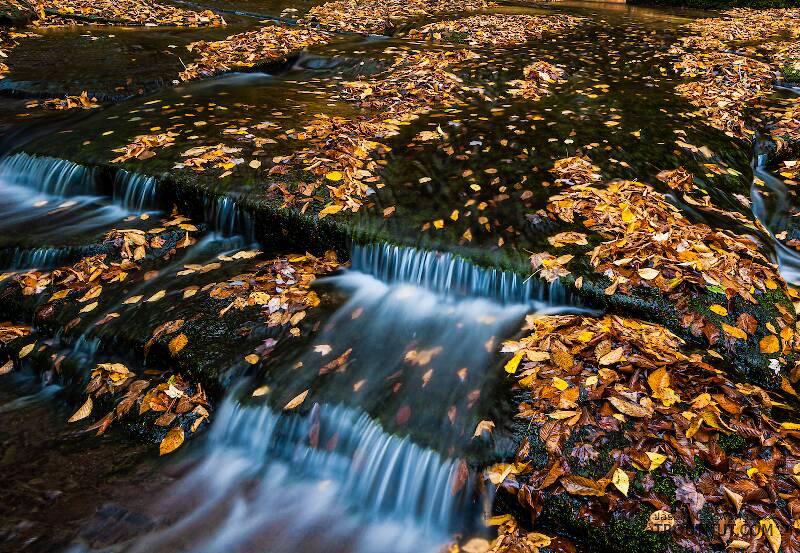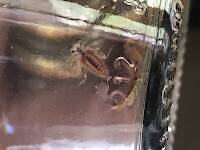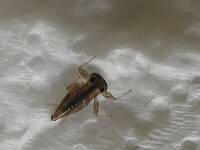
Salmonflies
Pteronarcys californica
The giant Salmonflies of the Western mountains are legendary for their proclivity to elicit consistent dry-fly action and ferocious strikes.
Featured on the forum

Troutnut is a project started in 2003 by salmonid ecologist Jason "Troutnut" Neuswanger to help anglers and
fly tyers unabashedly embrace the entomological side of the sport. Learn more about Troutnut or
support the project for an enhanced experience here.
Creno on May 4, 2012May 4th, 2012, 1:49 pm EDT
Nope - and more likely Rhyacophila - from what I can see of venation and wing shape they are not right for Hydropsyche
PaulRoberts on May 4, 2012May 4th, 2012, 2:44 pm EDT
Ah! That would make sense. Seemed early. I never saw any attempting to dive either. I did see a group together on the wet side of a boulder close to the water and actively dancing around there. I wondered at first if they weren't pasting eggs there -to fall in later?? But then thought they might slip in to dive from there. But I spooked them off trying to get a photo.
I thought the wing shape was sufficiently angled to be Hydro. Guess not. Thank you.
I thought the wing shape was sufficiently angled to be Hydro. Guess not. Thank you.
Entoman on May 6, 2012May 6th, 2012, 12:42 am EDT
Those two look to be either different species or sexes. How big, Paul?
It looks an awful lot like a species we have out here that I'm pretty familiar with as it's a critter the trout are pretty fond of. Check out the spotting pattern and venation on this photo of Rhyacophila brunnea. Seems pretty close to me if you look past the reflections and the fact it's a pinned specimen. When alive they're the spitting image of yours but perhaps a bit browner out here. The bodies are pretty green. http://www.biodiversity.ubc.ca/entomology_photos/Trichoptera/Rhyacophilidae/%20Rhyacophila%20brunnea%20(3lateral)%20%20.jpg
It looks an awful lot like a species we have out here that I'm pretty familiar with as it's a critter the trout are pretty fond of. Check out the spotting pattern and venation on this photo of Rhyacophila brunnea. Seems pretty close to me if you look past the reflections and the fact it's a pinned specimen. When alive they're the spitting image of yours but perhaps a bit browner out here. The bodies are pretty green. http://www.biodiversity.ubc.ca/entomology_photos/Trichoptera/Rhyacophilidae/%20Rhyacophila%20brunnea%20(3lateral)%20%20.jpg
"It's not that I find fishing so important, it's just that I find all other endeavors of Man equally unimportant... And not nearly as much fun!" Robert Traver, Anatomy of a Fisherman
PaulRoberts on May 6, 2012May 6th, 2012, 7:52 am EDT
They were variable in size (16 to 14) but Ames book states that that is pretty common among caddisflies, both between sexes and individually.
Mine looks more heavily marked than the image you provided. A shared feature amongst mine was the light silvery rectangular patch top central on the folded wings. It really showed up from a distance.
LaFontaine's book lists only one species emerging this early in the West -have to look it up again though. He also said it's a herbivorous species and habitat was a match.
Mine looks more heavily marked than the image you provided. A shared feature amongst mine was the light silvery rectangular patch top central on the folded wings. It really showed up from a distance.
LaFontaine's book lists only one species emerging this early in the West -have to look it up again though. He also said it's a herbivorous species and habitat was a match.
Entoman on May 6, 2012May 6th, 2012, 9:41 am EDT
Mine looks more heavily marked than the image you provided. A shared feature amongst mine was the light silvery rectangular patch top central on the folded wings. It really showed up from a distance.
Yes, I was comparing to your top photo. Though darker (& hence more obvious), compare them cell by cell and the spotting pattern is remarkably similar. I'd like to hear Dave's thoughts on the possibility that the pinned specimen has bleached out.
They were variable in size (16 to 14)
So the critter from head to wingtip was under 10mm? That sounds a little small for brunnea, I think. But even if it weren't, there's a reason Dave answered "Nope" to your question of I.D. possibility. There are at least 17 species in CO, probably more. I know that Dave co-authored a paper on distribution of Colorado species awhile back, so he can obviously give a more accurate count. Anyway, the point is we can rule many species out, but there's a whole bunch we can't so to attempt an I.D. from a photo beyond genus at this point is probably just pure speculation. Fun, though!:)
BTW - if you look for brunnea in LaFontaine, you won't find it as it's listed under its synonym R. acropedes, which I believe is the critter you are referring to.
"It's not that I find fishing so important, it's just that I find all other endeavors of Man equally unimportant... And not nearly as much fun!" Robert Traver, Anatomy of a Fisherman
PaulRoberts on May 6, 2012May 6th, 2012, 1:32 pm EDT
Yes, R. acropedes is what he describes as flying in April.
PaulRoberts on May 6, 2012May 6th, 2012, 3:02 pm EDT
This image shows R. vetina, which has the bright central wing spot.
http://www.biodiversity.ubc.ca/entomology_photos/Trichoptera/Rhyacophilidae/
I don't know if they are found in CO though. Is there a NA species like there is for mays and stones?
http://www.biodiversity.ubc.ca/entomology_photos/Trichoptera/Rhyacophilidae/
I don't know if they are found in CO though. Is there a NA species like there is for mays and stones?
Entoman on May 6, 2012May 6th, 2012, 7:06 pm EDT
I noticed that photo, but from what I could find out, its distribution lies in the Cascades north of CA and seems isolated from the Rockies by the High Desert. There are some significant differences in the rest of the spotting pattern as well. Also, the two species are from different groups and I think vetina is a summer emerger. If you get a chance to get back to the creek soon, look for larvae that have just encased themselves for pupation (they are easy to mistake for some kind of seed pod but the larva or pupa is easily visible inside). If you are a rock picker, they will be covered with grains of aggregate that easily knocks away, if you use a kick net, you will end up with just the "seed pods" in the net. Break one open and look for either two or three-branched lateral gills on the abdominal segs. Uncased larvae may or may not be this early emerging species.
As for state distribution lists of caddis, Roger (Taxon) has a great one he's worked very hard to assemble. I've found it to be as handy as it is accurate.
http://flyfishingentomology.com/NACaddisflyDistributionQuery.htm
As for state distribution lists of caddis, Roger (Taxon) has a great one he's worked very hard to assemble. I've found it to be as handy as it is accurate.
http://flyfishingentomology.com/NACaddisflyDistributionQuery.htm
"It's not that I find fishing so important, it's just that I find all other endeavors of Man equally unimportant... And not nearly as much fun!" Robert Traver, Anatomy of a Fisherman
PaulRoberts on May 6, 2012May 6th, 2012, 9:16 pm EDT
Thanks so much, Kurt.
I've seen the Rhyaco pupal cases -kind of like a vitamin capsule. If I get back I'll try to find one. Interestingly brunnea is listed as common in a local study. And a larva I saw shows it being almost blue color, a color I've seen and tied in one of my Rhyaco larvael ties.
I've seen the Rhyaco pupal cases -kind of like a vitamin capsule. If I get back I'll try to find one. Interestingly brunnea is listed as common in a local study. And a larva I saw shows it being almost blue color, a color I've seen and tied in one of my Rhyaco larvael ties.
Entoman on May 6, 2012May 6th, 2012, 9:55 pm EDT
Paul -
You're welcome. Nothing I enjoy more (besides bugs & fishing) than our conversations.
Ha! Even a better analogy! Kind of an elongated vitamin E pill... Wished I thought of it! One to keep for students...
You're welcome. Nothing I enjoy more (besides bugs & fishing) than our conversations.
I've seen the Rhyaco pupal cases -kind of like a vitamin capsule.
Ha! Even a better analogy! Kind of an elongated vitamin E pill... Wished I thought of it! One to keep for students...
"It's not that I find fishing so important, it's just that I find all other endeavors of Man equally unimportant... And not nearly as much fun!" Robert Traver, Anatomy of a Fisherman
Creno on May 7, 2012May 7th, 2012, 4:53 pm EDT
Sorry folks but this concept of trying to determine a species based on the time of year and watershed it was collected in goes down a path I won't walk. One more time - ya cannot responsibly presume the only taxa you will collect are the ones that have been previously reported :-) In this genus you will need to look at its butt.
PaulRoberts on May 7, 2012May 7th, 2012, 6:08 pm EDT
Thanks, Dave. I hear you. There just isn't enough known, and/or too much variability within to assume much. I'll just call it Rhyacophila.
Creno on May 8, 2012May 8th, 2012, 3:39 pm EDT
Paul- there is never enough known - but never too much variability! Just look at the flies on this site alone. How many different ways can ya put stuff on a hook......... :-)
PaulRoberts on May 10, 2012May 10th, 2012, 8:44 am EDT
They were variable in size (16 to 14)
So the critter from head to wingtip was under 10mm?
No, I'd say they were over 10 but under 14mm.
Quick Reply
Related Discussions
Topic
Replies
Last Reply
1
Sep 5, 2006
by Troutnut
by Troutnut








